Dominican Art
Christian sacred art is an attempt to illustrate, supplement and portray, in tangible form, the principles of Christianity. It can inspire and encourage your faith. Many people are confused about statues and all religious art for that matter.We are not meant to worship these, but they are to inspire us in a specific way as the artist intended.
Interactive Table of Contents For This Page
- 1. The Madonna delle Ombre
- 2. Dominican Saints - Dominican House of Studies in Washington, D.C.
- 2b. Rosary Altar and Altar Piece, House of Studies, Washington, D.C.
- 3. The Crucifixion by Fra Angelico
- 4. The Miraculous Image of the Madonna of San Sisto
- 5. Museum of San Marco and the Frescos of Fra Angelico - Video Clip
- 6. Dominican Photographs by Fr. Lawrence Lew O.P.
- 7. View this amazing restoration by Advancing Women Artists
- 8. 800th Jubilee Painting Commissioned by the Province of St. Joseph
- 9. General Iconography
The Madonna delle Ombre
(The Madonna of the Shadows) by Fra Angelico is a fresco by Fra Angelico situated in the east corridor of the dormitory of the monastery of San Marco. It is here where the clerics and novices would gather for their morning prayers (Hood). The work is distinctly divided into two equal halves. The top half depicts the theme of the Sacred Conversation, which shows the Virgin Mary with the infant Jesus on her lap and surrounded by eight saints in an informal grouping, all within a unified perspectival space. The bottom half of the painting is comprised entirely of trompe-l’oeil, or fictive, marble panels.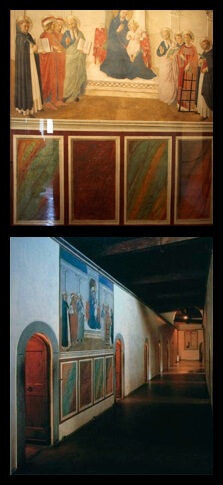
The bottom half of the fresco, previously considered to be a mere decorative element of the work, has been argued to be a symbolic representation of Christ’s tomb (Didi-Huberman). The representation of the painted marble panels is at eye-level with the viewer and is visually pushed forward in the pictorial plane. If the monks were indeed gathering here to pray, the marble would have been situated in the position of a sepulcher below an altar, acting as a memento mori similar to what we see in Massaccio’s Trinity and common to the Florentine Renaissance.
Also notable, the depiction of the marble is splattered with paint, applied by the artist after the surface of the fresco had dried. Didi-Huberman argues that Fra Angelico knew how to paint marble in a highly precise manner, suggesting that this portrayal is intended to be representative of more than just marble. Thus, the marble is not intended to be mimetic but figurative, representing the mystery of the incarnation of the word of God as described by Saint Bernardino as “the unfigurable in the figure.”
Comprising the lower half of the painting with four panels in succession may also have served to represent the four-fold method of interpreting the scripture, involving: allegory, typology, tropology, and analogy. If so, the panels would have been useful to monks as both a spiritual conundrum and a meditative tool.
Handout .pdf here (.pdf)
Dominican Saints - Dominican House of Studies in Washington, D.C.
Dominican Saints (View Separate Image Here) This wall sized painting hangs in the refectory of the Dominican House of Studies in Washington, D.C. It was painted by Sister Mary of the Compassion, O.P. Dominican saints gather around the crucified Christ expressing adoration and gratitude to God. St. Dominic and St. Catherine of Siena kneel next to Christ.
Note the exquisite detail of the image. The saints figured here are:
Bottom Row 1 left to right:
† Saint Rose of Lima (1586–1617)
† Fra Angelico (now Blessed John of Fiesole) (1386–1455)
† Saint John of Gorkum (?–1572)
† Saint Catherine of Siena (1347–1380)
† Holy Father Dominic (1170–1221)
† Saint Catherine de Ricci (1522–1589)
† Saint Martin de Porres (1579–1639)
† Sister Maria (Mystic living at the Monastery with the artist)
† Saint Louis Bertrand (1526–1581)
Top Row 2, left to right:
† Saint Raymond of Peñafort (1175–1275)
† Saint Antoninus of Florence, Bishop (1389–1459)
† Saint Margaret of Hungary (1242–1271)
† Saint Vincent Ferrer (1350–1419)
† Saint Albert the Great, Bishop (1207–1280)
† Saint Thomas Aquinas (1225–1274)
† Blessed Raymond of Capua (1330–1399)
† Alan de la Roche (1428–1479)
† Saint Peter Martyr (1206–1252)
† Saint Pius V, Pope (1504–1572)
† Saint Hyacinth (1185–1257)
† Blessed Lucy of Narni (1476–1544)
† Saint Agnes of Montepulciano (1268–1317)
† Two unknown brothers
Translation of the text at the bottom: Stanza 6 of Saint Thomas Aquinas’ Eucharistic hymn Adoro te Devote:
Rosary Altar and Altar Piece, House of Studies, Washington, D.C.
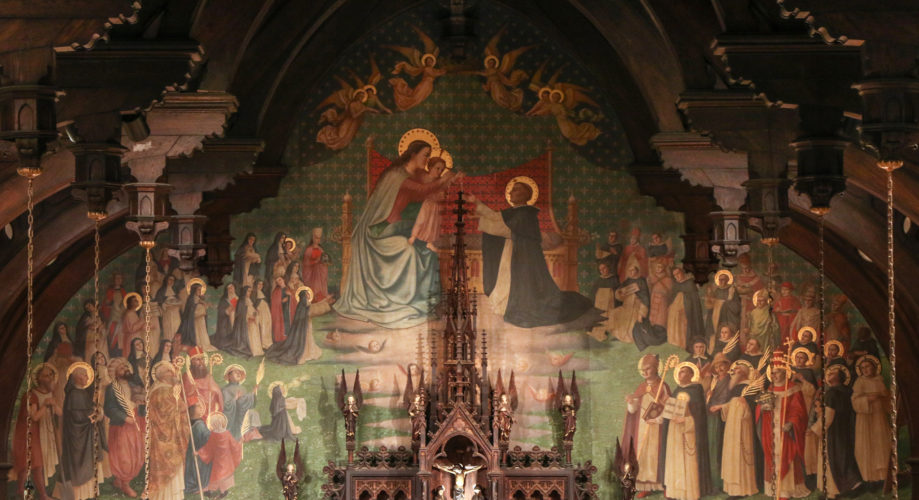
by Br. Charles M. Daley, O.P. The visitor's attention upon entering the chapel of the Dominican House of Studies at Washington, is inevitably drawn to the large painting of the saints and blessed of the Order over the main altar. Although this picture may not be a masterpiece of art, it is, nevertheless, a noteworthy illustration of the Flemish school, singularly rich in Christian symbolism for it colorfully portrays at a glance the varied lives of many holy Dominicans.......
(continues here pdf link)
The Crucifixion by Fra Angelico
1441-43 Fresco, Convent of San Marco, FlorenceJesus is pictured as in most 15th-century Crucifixion images, his eyes closed in death and the weight of his body making his arms sag. As in Bridget of Sweden's vision, his two feet are held by a single nail, he wears a tied-up cloth, and his mother is about to faint. An even more ancient tradition is the skull on a hillock at the base of the cross, a visual pun on Calvary, "the place of the skull." In this enormous fresco the artist was able to include on the plaque the full text ordered by Pilate.
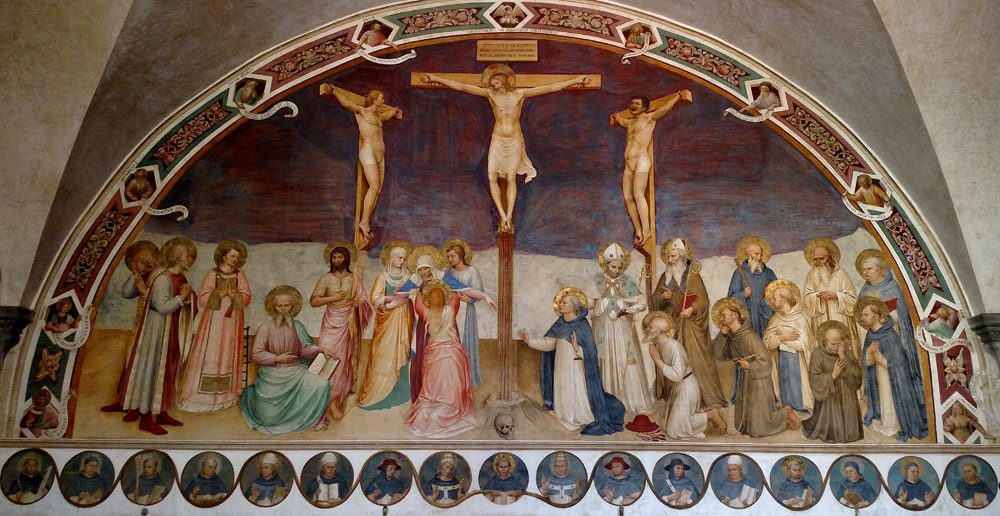 But the fresco's most remarkable feature is the arching border. A repeated theme in the gospels is that Christ's death and
resurrection were foretold by the prophets. Accordingly, the artist sets into the border portraits of eight Old Testament prophets
and patriarchs, two Gentiles said to have sensed that something was to happen, and the pelican that had become conventional atop the crucifix.
Each of these holds a banderole with a quotation addressing Christ's death and resurrection that would be familiar to the friars from the
breviary and the missal. Each of the following links will take you to an explanation of the person pictured, the phrase on the banderole,
its provenance, a translation, and how it applies to the Crucifixion. Left to right on the border, the insets are:
But the fresco's most remarkable feature is the arching border. A repeated theme in the gospels is that Christ's death and
resurrection were foretold by the prophets. Accordingly, the artist sets into the border portraits of eight Old Testament prophets
and patriarchs, two Gentiles said to have sensed that something was to happen, and the pelican that had become conventional atop the crucifix.
Each of these holds a banderole with a quotation addressing Christ's death and resurrection that would be familiar to the friars from the
breviary and the missal. Each of the following links will take you to an explanation of the person pictured, the phrase on the banderole,
its provenance, a translation, and how it applies to the Crucifixion. Left to right on the border, the insets are:
- Dionysus the Areopagite
- Daniel
- Zacharias
- Jacob
- David
- the pelican
- Isaiah
- Jeremiah
- Ezekiel
- Job
- The Erythrean Sibyl
Along the bottom border are St. Dominic (directly below the cross) and sixteen Dominican saints and blesseds. The main scene features a group of saints important to the Medici family on the left and on the right a group with three of the "Doctors of the Church" and men representing the major religious orders of the day. The figures are (left to right):
- Saints Cosmas and Damian, surprisingly garbed as if clerics. Cosmas is the namesake of Cosimo de' Medici (1389-1464), who governed Florence at the time of this fresco.
- St. Lawrence, with his attribute, the gridiron. He is the namesake of Cosimo's late brother Lorenzo (1395-1440).
- St. Mark the patron saint of the San Marco church and convent, pointing to his gospel.
- St. John the Baptist, patron saint of Florence, with his camel-skin tunic.
- Mary the wife of Cleophas, a kinswoman of the Virgin Mary.
- The Virgin Mary (red tunic and blue mantle).
- Mary Magdalene kneeling before Mary (long, blonde hair).
- St. John the Evangelist.
- St. Dominic in the habit of his order, distinguished from the other Dominicans in the group by the a star above his forehead.
- St. Augustine, one of the four "Doctors of the Church."
- St. Jerome, with his cardinal's hat on the ground before him, also one of the Doctors of the Cnurch.
- St. Ambrose with a pen and book referring to his writings, the third Doctor of the Church. It is not clear why the artist did not include the fourth, Pope Gregory the Great. At the time Florence and the Medici were on good terms with the Papacy.
- St. Francis of Assisi, in his Franciscan habit but without any indication of the stigmata.
- St. Benedict, founder of the Benedictines, standing with a handful of sticks, an attribute referencing his advice on monks finding strength in unity.
- St. Bernard of Clairvaux, representing the Cistercian order.
- St. Romuald, founder of the Camaldolese order.
- St. John Gualbert, of the Valombrosan order, kneeling in front of St. Romuald.
- St. Peter Martyr, standing beside St. John Gualbert (Dominican habit, gash in his head).
- St. Thomas Aquinas (Dominican habit, a shining sun on his breast).
- The two thieves are starkly distinguished. The one on Jesus' right is young, handsome, and blond. He gazes calmly on his savior. The other thief, with messy black hair, squints into the distance and howls in agony.
The Miraculous Image of the Madonna of San Sisto
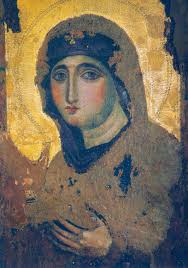
Before the masterful frescoes of Beato Fra Angelico graced the cloister of San Marco, the Order of Preachers possessed an artistic work of great character and heritage in the miraculous image of the Madonna of San Sisto in Rome. This icon of Our Lady was thought during the Middle Ages to have been designed by Saint Luke the Evangelist and to have been painted by angels. Legend held that a holy man from the East brought it to Rome. There it was acquired by three brothers who were exiles from Constantinople, presumably because their adherence to orthodox Christianity ran into conflict with an outbreak of monophysitism or iconoclasm. The image was placed in the Church of Santa Agata in Tum outside the Appian Way, which, in honor of the icon, became known as, alternatively, Santa Maria in Turri and Santa Maria in Tempulo. Confirming parts of this medieval legend, modem historical study has indicated that this Madonna is of Byzantine origin and was venerated at least by the end of the fifth century.
When Saint Dominic was charged by Pope Honorius III to establish a reformed community of nuns at San Sisto in Rome, one of the communities from which nuns were voluntarily drawn was the monastery at Santa Maria in Tempulo. St. Dominic lavished his attention upon the nuns of Santa Maria, preaching to them and giving them spiritual direction. It was to each of these same women in 1219 that St. Dominic brought wooden spoons which he had carried on a journey from Spain. At that same time, he received the promise of the nuns that they would enter the new community of San Sisto. However, the mere possibility of the nuns moving from their monastery into a stricter community caused their relatives and friends to protest vociferously. After further entreaties from St. Dominic, most of the nuns agreed to join the new community of San Sisto.
The nuns placed one caveat on their promise: that the miraculous image of the Madonna in Santa Maria in Tempulo should also come with them. This was no ordinary request. Legend had it that in the tenth century Pope Sergi us III had tried to move the painting into the Lateran, but it had returned miraculously to its original home. God seemingly wanted the painting to remain in Santa Maria in Tempulo.
St. Dominic was not daunted by the challenge. On the First Sunday of Lent, February 28, 1221, Our Holy Father gave the habit and received in his hands the profession of the nuns entering San Sisto. During the following night, St. Dominic carried the miraculous image of the Madonna to its new home at San Sisto. The painting did not fly back on its own accord, thus bestowing the divine seal of approval to St. Dominic's foundation.
The miraculous Madonna remained at San Sisto until 1575, when it was transferred to San Domenico and Sisto on the Quirinal where the nuns had relocated upon the urging of Pope Saint Pius V. After the monastery became the home of the Angelicum, the image was under the care of the friars for a time. In 1931, however, the image was placed in Santa Maria del Rosario e della Febbre a Monte Mario where the nuns had moved into a new monastery. The image was restored by Dr. Carlo Bertelli in the 1950s.
Museum of San Marco and the Frescos of Fra Angelico - Video Clip
The Sala dell’Ospizio, where pilgrims were received, is now a gallery where many of Fra Angelico’s most important panel paintings have been gathered together. They include the Deposition painted for Palla Strozzi, the Pala di San Marco, commissioned by the Medici, and the Tabernacle of the Linaioli, made in 1433-1434 with the assistance of Lorenzo Ghiberti, who designed the frame. In the Chapter House, he painted a complex and allegorical Crucifixion, finished in 1442.
Take a video tour (above) of the cells of San Marco here and see the wonderful Fra Angelico works!
An extrodinary collection of Dominican Photographs by Fr. Lawrence Lew O.P.
Church art, architecture, historic buildings, places and events, scenes of natural beauty, and various saints (here)View this amazing restoration by Advancing Women Artists
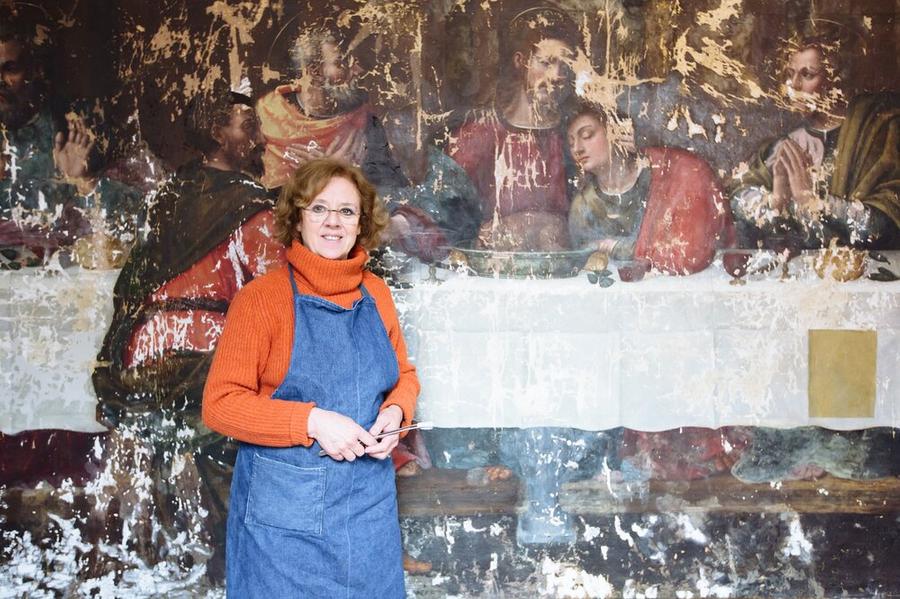
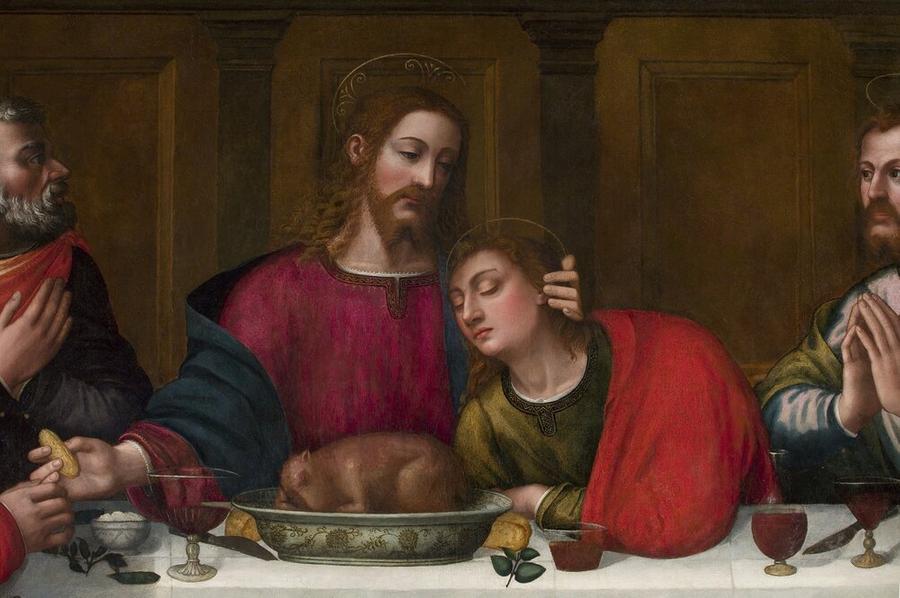 Restoration of the Last Supper in Santa Maria Novella Museum in Florence
Restoration of the Last Supper in Santa Maria Novella Museum in Florence
800th Jubilee Painting Commissioned by the Province of St. Joseph
By: Bernadette Carstensen(Purchase Prints Here)
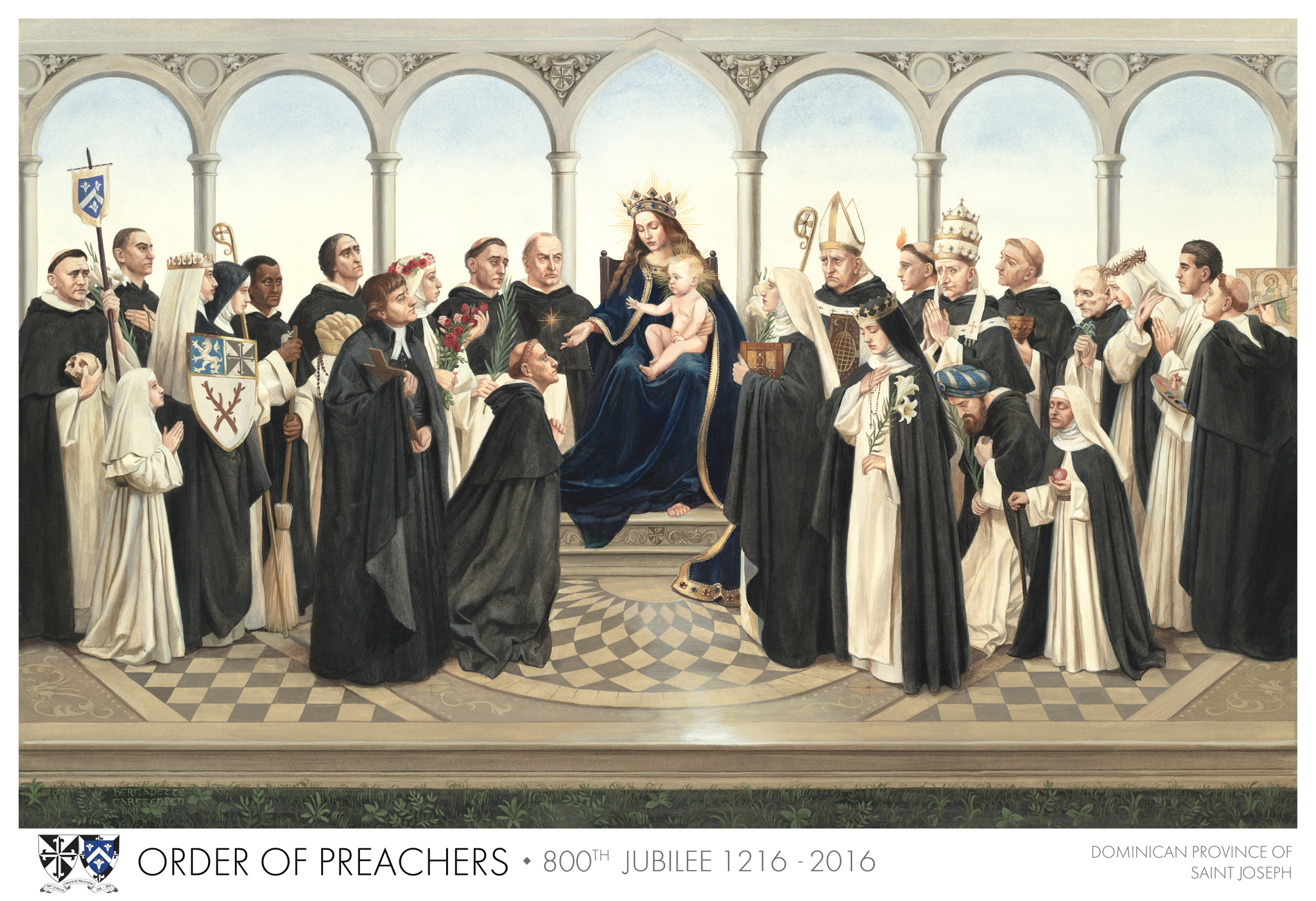
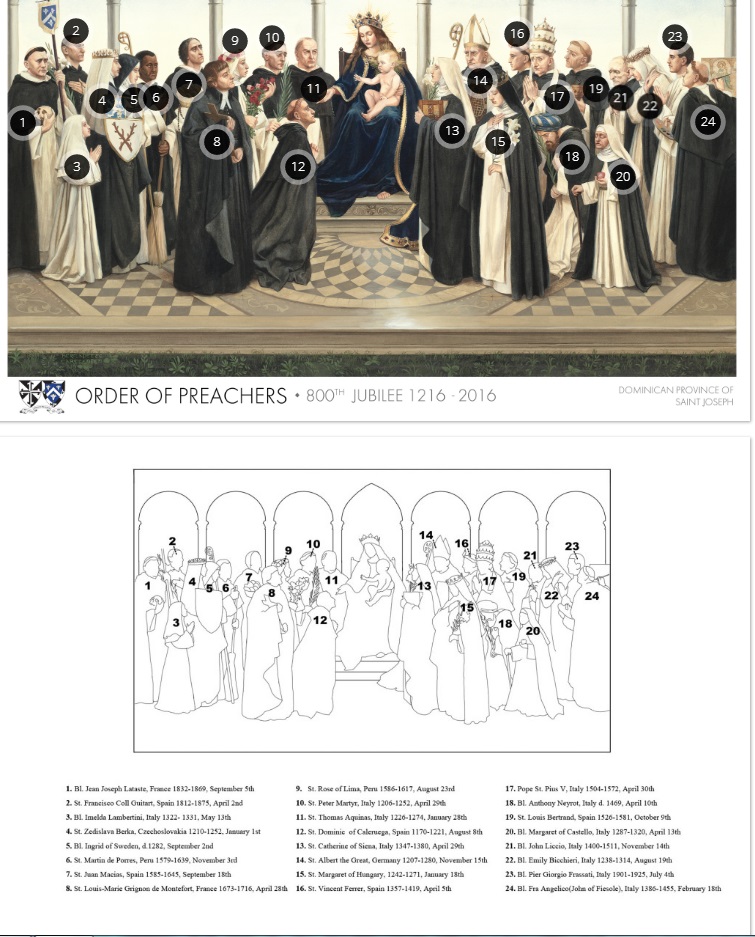
General Iconography
(the visual images and symbols used in a work of art or the study or interpretation of these)
Catholic artistic tradition assigns each saint particular symbols that denote the Saint's martyrdom, miracles, or circumstances of their lives. These symbols serve to identify the saints, and aids to memory of a Saint's life and actions, and as symbols of spiritual ideals.Historically God himself has used statues, for example, in the angel statues where their wings covered the ark of the covenant, and in the desert, where one had to look upon the bronze serpent that Moses had made at God’s command, in order to be saved.
The Saints often hold the tools of their Salvation. The sheer number of different items depicted in Icons show us the diversity of ways in which God calls us. The Cross, the Gospel, holy Wisdom, the Church: all ultimately lead to Christ, of course, yet the richness of items points to the abundance of His Mercy and Grace. In paintings even the backgrounds or figures of particular animals have meaning.
In order to more deeply appreciate these art forms, several websites have accumulated lists of items and their meanings. These items include: fruits, trees, flowers, work tools, animals, birds, fish, insects, religious objects, colors, clothing, food, and even the human elements. For a general understanding of many of these, see this download: (.pdf) Dominican Iconography
- St Peter of Verona (View pdf Here)